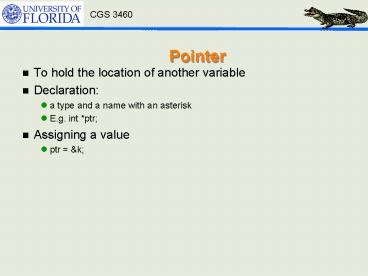Pointer - PowerPoint PPT Presentation
1 / 19
Title:
Pointer
Description:
Can grow and shrink as necessary Insert and delete node with ... Id: 2. p. CGS 3460. Demo. http://www.cosc.canterbury.ac.nz/mukundan/dsal/LinkListAppl.html ... – PowerPoint PPT presentation
Number of Views:19
Avg rating:3.0/5.0
Title: Pointer
1
Pointer
- To hold the location of another variable
- Declaration
- a type and a name with an asterisk
- E.g. int ptr
- Assigning a value
- ptr k
2
Pointers and Structures
- Declaration
- struct date datePtr
- Initialization
- datePtr today
- Access members
- (datePtr).year
- datePtr-gtyear
struct date int day char month10 int
year struct date today
3
Structures contains pointers
- Pointers can be members in a structure
- struct date
- int day
- char month
- int year
- Special case
- struct date
- int day
- char month
- int year
- struct date next
4
Linked List
- What is a list?
- Node
- Link
- An alternative to Array
- Pros/Cons
- More flexible
- Can grow and shrink as necessary
- Insert and delete node with particular index
- - Cannot be randomly accessed
- sorted (ordered list)
5
Linked List
- Operations
- Start a list
- Create a node
- Insert
- Delete
- Search
6
Memory Allocation
- malloc is by far most frequently used
- Defined in ltstdlib.hgt
- void malloc(size_t size)
- Allocate memory space with size bytes
- Why does it return a void pointer?
- Because it doesn't matter to malloc to what type
this memory will be used for - If no memory of the size available, will return
null - Be sure to check whether it is null
7
Function sizeof
- Helpful when dynamically allocating memory
- sizeof(data type) returns a size_t of the data
type in byte(s) - For a typical 32-bit machine
- sizeof(int) returns 4
8
Free Allocated Space
- Very important
- System wont automatically take back memory space
allocated through malloc - If not free, a memory leak
- How?
- Use function
- void free(void ptr)
- It release the memory space referenced by ptr
- Note that free can take in NULL, as specified by
ANSI
9
Build a Linked List
- Build a structure representing a node
- struct studentRecord
- int idNum
- struct studentRecord next
- Initialize the node
- struct studentRecord first NULL
NULL
first
10
Create a node
- Follow these steps
- Allocate memory for the node
- Set data into the node
- struct studentRecord new_student
- new_student malloc(sizeof(struct studentRecord
)) - ( new_student).idNum 1
- new_student ?next NULL
new_student
11
Insert a node insert in the front(empty)
- Follow these steps
- Create a node
- Set the node pointing to the front of the list
- Set it as the starting node of this list
- new_student malloc(sizeof(struct studentRecord
)) - new_student ? idNum 2
- new_student ?next first
- first new_student
NULL
new_student
first
12
Insert a node insert in the front(not empty)
- Follow these steps
- Create a node
- Set the node pointing to the front of the list
- Set it as the starting node of this list
- new_student malloc(sizeof(struct studentRecord
)) - new_student ? idNum 2
- new_student ?next first
- first new_student
NULL
first
new_student
13
Insert a node insert in middle
- To insert a new node after node called pt, follow
these steps - Create a node
- Set the node pointing to the next node after pt
in the list - Set it as the next node of this list after pt
- new_student malloc(sizeof(struct studentRecord
)) - new_student ? idNum 2
- new_student ?next pt ? next
- pt ? next new_student
first
pt
NULL
new_student
14
Traversing along the List
- for (p first p ! NULL p p?next)
- .
- int Length(struct studentRecord first)
- int count 0
- struct studentRecord current first
- while (current ! NULL)
- count
- currentcurrent-gtnext
- return(count)
15
Get nth Element in List
- int GetNth(struct studentRecord first, int
index) - struct studentRecord current first
- int count 0 // the index of the node
- while (current ! NULL)
- if (count index)
- return(current ? idNum )
- count
- current current ? next
- return(-1) // if we get to this line, the caller
was asking - // for a non-existent element
16
Delete
- Delete (almost reverse of insertion)
- locating the node to be deleted (see search a
linked list) - altering the previous node to bypass the deleted
node - calling free to reclaim the space occupied by the
deleted node
17
Example for deleting
- To delete a node p from a linked list, you should
also know the node which is in front of p in the
list (q) - if (p ! NULL)
- q ? next p ? next
- free(p)
q
p
NULL
first
18
Example for deleting
- If deleting the first node in the list
- if( p first )
- first p-gtnext
- free(p)
p
NULL
first
19
Demo
- http//www.cosc.canterbury.ac.nz/mukundan/dsal/Lin
kListAppl.html































